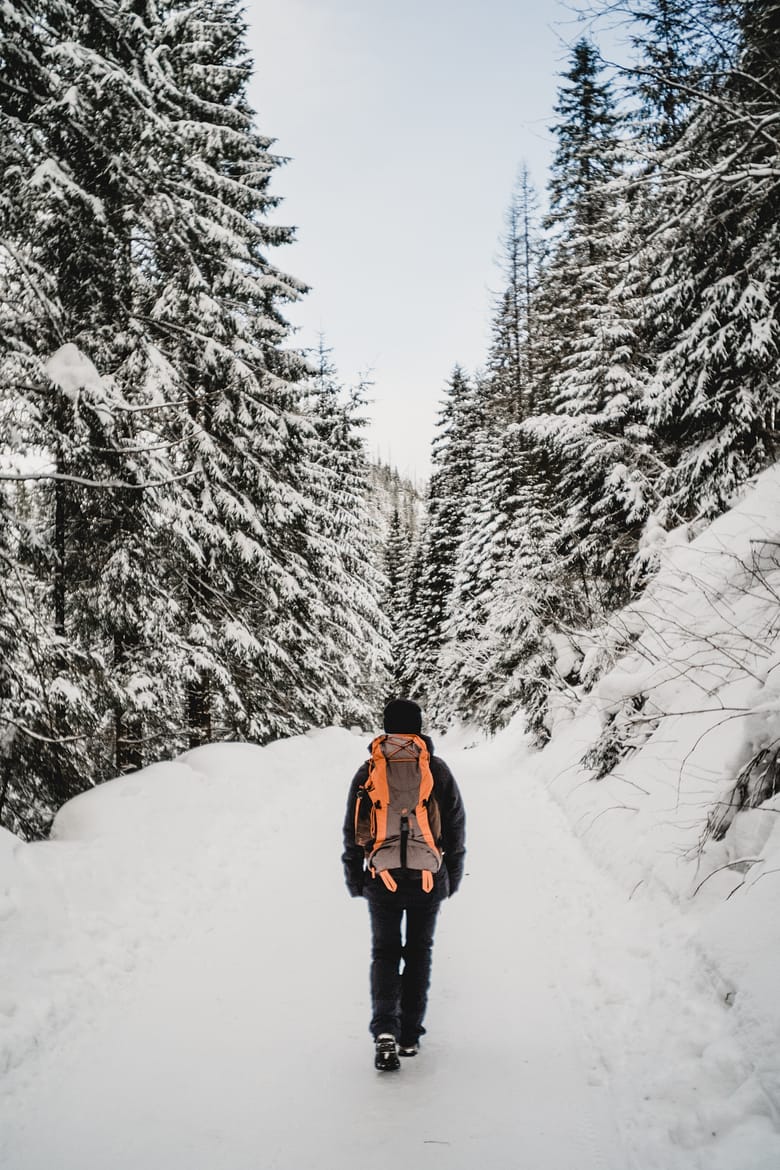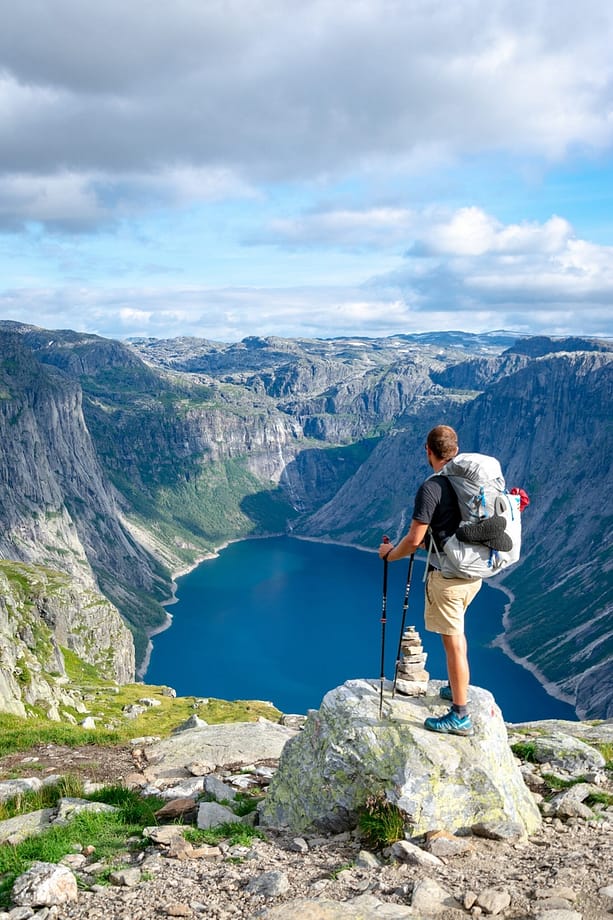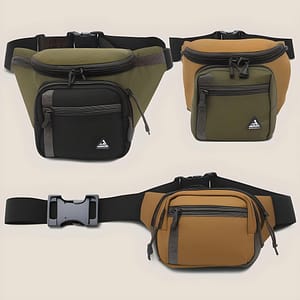Hey there, fellow adventure seekers, Are you tired of being cooped up in your cozy little cave of comfort? Well, it’s time to lace up those boots, grab your trusty backpack, and embark on a hiking journey like no other. Whether you’re a city dweller craving a breath of fresh air or a nature enthusiast looking to explore the great outdoors, this ultimate hiking guide for beginners is here to rescue you from your couch potato status and transform you into a trailblazing champion.
Now, before you start picturing yourself conquering the highest peaks and wrestling wild bears (please don’t wrestle bears, just to be clear), let’s take it one step at a time. This guide is designed to ease you into the world of hiking, ensuring that you have a blast while staying safe and avoiding any embarrassing falls…unless they’re the type that make great stories around the campfire.
What is the best time of day to go hiking?
I’m about to enlighten you on the best time of day to go hiking. Are you ready? The best time of day to go hiking is… whenever the heck you feel like it!
Now, I know what you’re thinking. “Wow, this guide is really helpful,” you say. But hear me out, Hiking is all about enjoying the great outdoors and having a darn good time. And you know what? You can do that at any time of day.
If you’re an early bird, go ahead and hit the trails at the crack of dawn. The air will be crisp and you’ll have the whole trail to yourself. Plus, you’ll have plenty of time to finish your hike and still have the rest of your day.
But if you’re more of a night owl, Hiking under the stars can be a magical experience. Just make sure you bring a headlamp or flashlight to light your way.
Now, I should mention that there are a couple of things to consider when choosing the time of day for your hike. If you’re hiking in a hot climate, you might want to avoid hiking during the peak heat of the day. Instead, go for early morning or late afternoon when the temperature is a little more bearable. Plus, you’ll get to witness the glorious sunrise or sunset painting the sky in shades of pink and orange.
Another important factor to consider is the length of your hike. If you’re planning an epic adventure you might want to start early to make sure you have enough daylight to complete your journey. On the other hand, if you’re just going for a leisurely stroll you have a bit more flexibility with your timing.
Hiking in the Winter vs Hiking in the Summer
Ah, the age-old debate: hiking in the winter vs hiking in the summer. Well, my friend, let me break it down for you.
Winter hiking
Winter hiking Sounds like a frosty adventure. If you’re the type of person who loves the crunch of snow under your boots and the sight of your breath forming little clouds in the freezing air, then winter hiking might just be your jam.
First things first, though, you gotta bundle up like a marshmallow. We’re talking layers upon layers, my friend. Start with a good base layer to wick away moisture, add a cozy insulating layer to keep you warm, and top it all off with a waterproof and windproof outer layer. Oh, and don’t forget a hat, gloves, and some warm socks to protect those tootsies. Trust me, frostbite is not a good look.
Now, winter hiking does come with its challenges. The trails can be slippery and icy, so be sure to invest in some crampons or microspikes to give you extra traction. And don’t even get me started on the shorter daylight hours. It’s like Mother Nature decided to hit the snooze button and leave us with less time to frolic in the snow. But fear not, my winter-loving friend, because the views are absolutely breathtaking. Snow-covered trees, frozen waterfalls, and that peaceful silence that only comes with a winter wonderland.
Summer hiking
Now, as for summer hiking, it is similar to winter hiking’s more laid-back, carefree sibling. If you prefer the warmth of the sun on your skin and the sweet scent of wildflowers in the air, then this season is your time to shine (literally, because you’ll probably be sweating a lot).
Now, let’s talk about the summer hiking essentials. First and foremost, sunscreen is your best friend. Trust me, you don’t want to end up looking like a lobster after a few hours on the trail. Slather on that SPF like it’s your job, and don’t forget to reapply throughout the day. Your skin will thank you.
Next up, hydration. Summer hiking means higher temperatures, which in turn means you’ll be sweating like a marathon runner at mile 20. Stay hydrated by bringing plenty of water with you. And no, a single water bottle won’t cut it. You need to channel your inner camel and carry enough water to last you the whole hike. Don’t worry, there are plenty of fancy hydration packs out there that will make you feel like a trail-blazing superhero.
Speaking of superheroes, let’s talk about clothing choices. Go for lightweight and breathable materials that wick away moisture and keep you cool. Trust me, you don’t want to be hiking in jeans or a wool sweater. We’re aiming for comfort here, people. Oh, and don’t forget to bring a hat and sunglasses to protect yourself from the scorching sun.

What type of backpack should I use?
First things first, forget about those tiny fashion backpacks you used to carry your school books in. We’re talking serious business here. You’ll need a backpack specifically designed for hiking. These bad boys come in various shapes and sizes, so let’s break it down for you.
1. Size Matters: Now, I’m not one to judge, but when it comes to backpacks, size does matter. You don’t want a pack that’s too big, or you’ll end up carrying unnecessary weight and looking like you’re about to embark on a months-long expedition. On the other hand, a pack that’s too small will have you squeezing your gear in like a game of Tetris. Aim for a pack with a capacity of 20-35 liters for day hikes and 40-60 liters for overnight trips.
2. Comfort is King: Hiking is all about enjoying the great outdoors, not dreading every step because your backpack feels like a medieval torture device. Look for a pack with padded shoulder straps and a waist belt that helps distribute the weight evenly.
Usually, there are two main types of backpacking, for day and night:
Daypacks
If you’re planning on conquering some shorter hikes, a daypack will be your best buddy. When it comes to choosing a daypack, there are a few things to consider:
a. Size: Just like Goldilocks, you want a backpack that’s not too big and not too small, but just right. Aim for a pack with a capacity between 20 to 35 liters. This should give you enough space to pack all your essentials without weighing you down like a lead balloon.
b. Comfort: Hiking is all about enjoying the great outdoors, not feeling like you’re being mauled by a grizzly bear. Look for a daypack with padded shoulder straps and a waist belt to help distribute the weight evenly. Trust me, your back will thank you later.
c. Organization: Remember that one time you couldn’t find your car keys and ended up turning your house upside down? Yeah, you don’t want that to happen on the trail. Look for a daypack with multiple pockets and compartments to keep your gear organized and easily accessible.
Overnight Packs
a. Size: You don’t want a pack that’s too small, or you’ll end up playing a frustrating game of backpacking Tetris. But you also don’t want a pack that’s too big, unless you want to look like you’re about to embark on a months-long expedition. Aim for a pack with a capacity of 40-60 liters. This should give you enough room to pack all your essentials without feeling like you’re carrying the entire contents of a grocery store.
b. Comfort. Hiking is all about enjoying the great outdoors, not dreading every step because your backpack feels like a medieval torture device. Look for a pack with padded shoulder straps and a waist belt that helps distribute the weight evenly. Your back will thank you later, trust me. And hey, if you’re feeling fancy, you can even find packs with adjustable suspension systems to really dial in that perfect fit.
c. Organization: I have 2 recommendations. The first one is packing cubes. These nifty little organizers are a hiker’s best friend. They come in different sizes and are perfect for keeping your clothes, gear, and snacks neatly separated. No more digging through a jumbled mess to find that one pair of clean socks. Plus, they help maximize space in your pack, so you can fit even more important things like extra marshmallows for s’mores. The second one is Ziplock bags. These versatile wonders are great for keeping your smaller items organized and protected. Need a place to store your phone, wallet, and keys? Ziplock bag it. Want to keep your trail mix from turning into a crumbly mess? Ziplock bag it. They’re lightweight, waterproof and they are perfect for hiking.

What type of clothing should I wear for a hike?
Before you hit the trails, let’s talk about the all-important question of what to wear. After all, you don’t want to end up looking like a fashion disaster while trying to conquer the great outdoors. Fear not, my friend, for I am here to guide you through the intricacies of hiking attire in the most entertaining way possible. So, let’s dive right in!
First things first, let’s talk about the golden rule of hiking fashion: layering. Think of it as the Inception of clothing – layers within layers. Why, you ask? Well, nature has a tendency to throw all sorts of weather at you, and you don’t want to be caught unprepared. Start with a moisture-wicking base layer that can keep you cool and dry like a superhero. Avoid cotton, because when it gets wet, it clings to you like a clingy ex. Go for materials like polyester or merino wool instead. Next up, we have the mid-layer. This is where you get to show off your personal style (or lack thereof) with a cozy fleece jacket or a lightweight sweater. It’s like a fashion show for the mountains. Just remember, breathable fabrics are your best friends here.
What type of footwear is best for hiking?
Ah, the age-old question of what to put on your precious little feet when you venture out into the wilderness. Well, my dear hiking newbie, let me enlighten you with some footwear wisdom. When it comes to hiking, your choice of shoes is crucial. You don’t want to end up with blisters the size of Mount Everest or slip and slide your way down a hill like a penguin on ice. So, let’s dive into the wonderful world of hiking footwear, shall we?
First things first, forget about those flimsy flip-flops or your favorite pair of high heels (unless you’re trying to prove that you’re the next hiking fashion icon, in which case, I salute your bravery). When it comes to hiking, you need something sturdy, reliable, and built for the great outdoors.
Hiking Boots
These bad boys are like the superheroes of hiking footwear. They offer ankle support, durable soles, and protection from rocks, roots, and all the other sneaky obstacles nature throws at you. They come in different heights, so choose ones that suit your trail preference. Just make sure to break them in before your big hiking adventure. Here are a few things to consider:
a. Comfort is key: Your hiking boots should feel like a warm hug for your feet, not a torture device. Look for boots with ample cushioning, a supportive midsole, and a roomy toe box. And unless you enjoy the feeling of your toes being squished together like sardines in a can, make sure there’s enough wiggle room.
b. Size matters: No, we’re not talking about your shoe size, although that’s important too. What we mean is that your hiking boots should fit just right. Not too loose, not too tight – just like a perfect handshake. Remember, you’ll be spending hours on your feet, so you want a fit that’s Goldilocks-approved – not too big, not too small, but just right.
c. Waterproof or not? That is the question: Nature has a funny way of surprising you with unexpected rain showers or muddy trails that make you question your life choices. So, if you want to keep your feet dry and happy, look for hiking boots with a waterproof membrane. Just make sure they’re breathable too, because nobody wants sweaty, swampy feet.
Hiking Shoes
If you’re not ready to commit to the full-on boot experience, hiking shoes might be your jam. They’re like the cool younger siblings of hiking boots, lightweight and more flexible. While they may not have all the ankle support and protection of boots, they’re still a great option for beginners.
Hiking shoes come in a variety of styles, so you can find the perfect fit for your feet and your fashion sense. Whether you prefer a low-cut shoe or a mid-height shoe, there’s something out there for everyone. Just make sure to try them on and walk around in them before making your final decision. You don’t want to end up with shoes that feel like a medieval torture device on your first hiking trip.
When it comes to materials, go for something breathable and water-resistant. You don’t want your feet feeling like they’re trapped in a swamp, do you? Look for shoes made with synthetic materials like nylon or polyester, or go for the more eco-friendly option of shoes made with recycled materials. Mother Earth will thank you.
Now, let’s talk about the all-important sole. You want a sole that can handle a variety of terrains, from rocky trails to muddy paths. Look for shoes with a grippy rubber sole that provides good traction. After all, you don’t want to be slipping and sliding like a cartoon character on a banana peel.

What safety items should I bring on a hike?
Yes, I know, safety sounds boring, but trust me, it’s important. So, without further ado, here are some safety items you should bring on a hike:
1. The almighty map and compass: Having a good old-fashioned map and compass combo can be a lifesaver. It’s not just for showing off your orienteering skills; it can actually help you find your way back to civilization if you happen to take a wrong turn and end up in some undiscovered land.
2. First aid kit: A basic first aid kit can save you from minor scrapes, cuts, or blisters. Trust me, you don’t want to be stuck on a remote trail with a blister the size of Mount Everest. So pack some band-aids, antiseptic wipes, and a few pain relievers, just in case.
3. Snacks and water: Hiking is no small feat. It’s gonna burn some calories, so you’ll need to refuel along the way. So, let’s dive into the world of trail munchies and hydration. Hiking can be a sweaty business, and you don’t want to end up like a dried-up raisin on the side of the trail. Make sure to bring a water bottle or hydration pack with enough water to keep you going. And here’s a pro tip: freeze some water the night before your hike. That way, you’ll have chilled water to sip on as the sun beats down on you.
Now, onto snacks. As mentioned, hiking burns calories, you will need to regain the calories you burn. But here’s the catch: you want to bring snacks that won’t turn into a gooey mess in your backpack. Go for snacks that are durable and won’t crumble into a million pieces. Think trail mix with nuts, dried fruits, and maybe a few chocolate chips for a sweet treat.
How should I plan my route?
Ah, planning your hiking route, my adventurous friend! This is where the real fun begins. But before we dive into the nitty-gritty details, let’s grab a cup of coffee and have a little chat about how to plan your route like a pro.
First things first, you need to decide on the level of difficulty you’re willing to tackle. Are you up for a leisurely stroll through a picturesque forest, or do you fancy a more challenging ascent up a majestic mountain? Know your limits and choose a trail that matches your hiking prowess.
Now, let’s get down to the nitty-gritty. Before embarking on your journey, it’s essential to do a little research. Find a reliable hiking guidebook, check out online forums, or even stalk some Instagram influencers who are well-versed in the art of hiking. Gather as much information as you can about the trail you’re interested in. You’ll want to know the distance, elevation gain, difficulty level, and any potential hazards or obstacles you may encounter along the way.
Once you’ve gathered all the necessary information, it’s time to whip out your trusty map and start plotting your route. Look for trailheads, parking areas, and any landmarks or points of interest along the way. Decide where you want to start and finish your hike, and then connect the dots to form your route. And don’t forget to take into account any time constraints or other commitments you may have.
In conclusion
In this hiking for beginners guide, we take a lighthearted approach to help you navigate the world of hiking. I want to emphasized the importance of staying hydrated and freeze your water bottle for a refreshing hike. Don’t forget some Tasty and nutritious snacks. Go for durable options like trail mix to fuel your adventure without turning into a messy disaster in your backpack. When it comes to planning your route, i advise considering your hiking abilities and doing thorough research on the trail you’re interested in. Use hiking guidebooks, online forums, and even Instagram influencers for valuable information. Finally, i must highlight the significance of plotting your route on a map, taking note of trailheads, parking areas, and any landmarks you want to visit. Don’t forget to factor in time constraints and other commitments before embarking on your journey.





